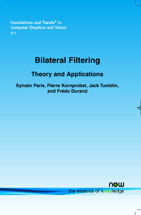Bilateral Filtering: Theory and Applications
By Sylvain Paris, Adobe Systems, Inc., USA, sparis@adobe.com | Pierre Kornprobst, NeuroMathComp Project Team INRIA, France, Pierre.Kornprobst@inria.fr | Jack Tumblin, Department of Electrical Engineering and Computer Science, Northwestern University, USA, jet@cs.northwestern.edu | Frédo Durand, Computer Science and Artificial Intelligence Laboratory, Massachusetts Institute of Technology, USA, fredo@mit.edu
Abstract
The bilateral filter is a non-linear technique that can blur an image while respecting strong edges. Its ability to decompose an image into different scales without causing haloes after modification has made it ubiquitous in computational photography applications such as tone mapping, style transfer, relighting, and denoising. This text provides a graphical, intuitive introduction to bilateral filtering, a practical guide for efficient implementation and an overview of its numerous applications, as well as mathematical analysis.
Bilateral Filtering
Bilateral filtering is one of the most popular image processing techniques. The bilateral filter is a nonlinear process that can blur an image while respecting strong edges. Its ability to decompose an image into different scales without causing haloes after modification has made it ubiquitous in computational photography applications such as tone mapping, style transfer, relighting, and denoising.
Bilateral Filtering: Theory and Applications provides a graphical, intuitive introduction to bilateral filtering, a practical guide for efficient implementation, an overview of its numerous applications, as well as mathematical analysis. This broad and detailed overview covers theoretical and practical issues that will be useful to researchers and software developers.
